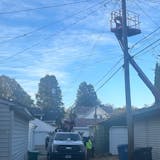Jen and Jeff Geisinger knew the open field across the road from their Brooklyn Park neighborhood wouldn't stay a pumpkin patch forever.
But they never dreamed of the project now pitched for that spot: a four-story, 2.6 million-square-foot fulfillment center that, if approved, could become the largest industrial building in the Twin Cities, nearly half the size of the Mall of America.
At City Hall, they call it "Project Hotdish." At the Geisinger house, it's "The Fulfillment Center That Shall Not Be Named" — or so reads a label on the three-ring binder holding their reams of research on the project.
Many residents have ditched the code name and insist it's Amazon, which employs more than 3,000 people in Minnesota and whose local operations are quickly growing. City leaders and the developer haven't named the Fortune 500 company behind the proposal, bound by an agreement not to disclose the prospective tenant.
The mystery project certainly resembles Amazon fulfillment centers taking shape across the country as the online retail giant expands its infrastructure in major metro areas, inching closer to where consumers live to cut delivery times. More than 175 fulfillment centers have been built worldwide, including one in Shakopee.
But Amazon has so far stayed mum on the Brooklyn Park project, and last week a company spokesperson declined to comment on it.
Brooklyn Park officials tout the 2,500 jobs and more than $5 million in tax revenue that "Hotdish" could serve up. The city has not been asked for any subsidies for the project, proposed for 72 acres in a business park near Winnetka and 109th avenues, close to Hwy. 169.
"It's a proposal that delivers many of the things we've been looking for," Mayor Jeff Lunde said.


